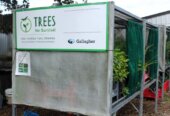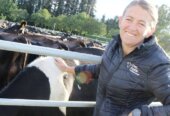
Cambridge High School principal Greg Thornton
During lockdown, Cambridge High School principal Greg Thornton began his commute to work by walking down his hallway to his son’s bedroom.
From this makeshift “office,” Thornton directed the school’s Covid-19 response, recording video call meetings for the school’s around 150 staff, or fielding briefings from the Ministry of Education.
But on May 18, Thornton was back in his real office, as a surprisingly high 91.7% of CHS’ 1700 students headed back to school.
Students filtered into their form classes; their hands squirted with hand sanitizer as they walked through the classroom doors. Their form teachers sat them down at spaced out desks and tried to reconnect: “how was lockdown?” “How are you feeling to be back?”
Thornton appeared almost like a hologram from a Sci-Fi film, greeting students with a video projected on the wall of each form class. “Kia Ora everyone and a warm welcome back to Cambridge High School,” he said, popping up digitally in front of each class. “I’ve got a big message for you today: Cambridge High School is safe.”
Thornton, who started at the helm of CHS in 2019, appeared cheerful and confident as he spoke—something he’s had to project throughout the crisis, according to deputy principal John McDonnell.
“Mr Thornton was always conscious of presenting to staff and students in a positive calm manner,” McDonnell reflected.
So what was lockdown like for CHS’ new(ish) principal—leading a school at a radical time for education?
Ever since the crisis started making headlines, Thornton’s main job was communication.
Before lockdown, “[Covid-19] was a great unknown,” he said. “And that was causing huge uncertainty for people.” Thornton describes the mentality people in Cambridge had as: “We might not have a case, but only because we haven’t tested for it. I think that was the general reaction—that it actually could be there.”
So when rumours started to spread, as the Avantidrome was closed after potentially being exposed to the virus by a visitor, Thornton got “back to the [school] community with the facts about what we actually knew about that case.” Then, when people started to worry that some of CHS’ staff or students had the virus and were being tested, Thornton again made sure to communicate with parents again: “No, that isn’t the case. And no, there aren’t any cases in the community.”
CHS, according to Thornton, got as much warning that New Zealand was moving into level four as “you guys got.” “On the Monday we knew that on Wednesday, we were closed,” he said.

Students have returned to Cambridge High School
The first challenge was to make sure that CHS’ s tudents could continue to learn that first week, with teachers essentially setting “cover work” for regular learning. Then, during the shifted-forward school holidays, the school worked to “upskill” its online learning capabilities, ready for a more long-term period out of class.
The “unknown” factor was a challenge for the school, too. In the early days of lockdown, the school had to constantly work out just how much to change the year plan—would the lockdown go on for four weeks, or six weeks, or eight weeks?
“There are very different ways that you plan for [each time period],” Thornton explains. “Do you have to change all of your units, or perhaps even the standards?” he reflected. “The biggest challenge was trying to figure out how much we shifted and redid what we needed to do.”
Two months later, school life at CHS is slowly making its way back to normal.
From June 2, sports practices and training will be able to start up. From June 22, the school is planning for sports and cultural events to kick off again.
The big question now, for Thornton and the staff, will be: just how much has lockdown affected students’ learning?
Some students are worried that, for example, with the revamped school year, they will have less opportunities to rack up NCEA credits.
In one year 11 Drama class, several standards have been dropped because they don’t work with social distancing requirements. Students will be finishing the year with at least 5 less credits than originally planned.
“Although speaking to students about their experience going into class, some found that they weren’t as far behind as they thought they were, others are at quite a different place,” Thornton said.
On May 13, NCEA exams were postponed from November 6 to 16. But will those extra ten days be enough time to fill up learning gaps?
“It will be for us,” Thornton said. “I think that there’ll be a lot that we’ll be able to catch up with during that time to get students ready.”
However, Thornton stressed that NZQA, the body that drives NCEA, is “really open to re-evaluating and seeing how things go and looking at changes.”
“But we’re pretty confident that that change alone will be enough for us,” he said.
Right now, the school’s focus is primarily on reconnecting with students.
“But when you turn up, the people make a difference and to actually see people around connecting makes, well, it maybe it makes it all worthwhile.”
“We’ve got quite a bit of time this year to catch up on missed pieces,” Thornton explained. But to help with that—and to make sure students’ NCEA concerns are addressed—the school is starting a programme of academic counselling.
“That might mean that in order to catch up students need some help with their time management or need some extra tutorial sessions or something along those lines.
“The first thing we need to do is to make sure people feel comfortable getting back here. And, obviously, that’s the health and safety aspect … but it’s also about connecting with each other again, in a way that people feel safe and welcome.
“And then off the back of that, once we know people are in a good space, we’ll pick up the learning and help them catch up,” he said.
Asked about whether seven weeks out of school may have damaged students’ learning, Thornton points to research on the effects of the lengthy American summer break on students.
Education experts are currently drawing parallels between what they call the “summer learning loss” phenomenon—whereby kids appear to regress academically during vacation—and the possible effects of closing schools due to Covid-19.
In particular, experts focus on how time away from school can increase the learning gap between kids from low income and high income families.
Keeping students at home can deepen a divergence in students’ learning, Thornton explained. “So some homes, for 100 different reasons might not have a very supportive environment for learning, whereas others have got an incredibly supportive one.”
“Whereas, you come into a classroom space, and it’s quite egalitarian. You come in and the teacher will do everything they can to help you learn.
“It becomes obvious that that’s not always the case in homes.”
For CHS, that gap may not be as big as in other communities, Thornton thinks.
“I think that we’re going to be okay. Some of the other schools have got some challenges, bigger challenges, maybe then we do to, to help with the gaps,” he said.
But there’s also the flip side of that—the drastic shift in teaching style lockdown forced upon CHS may be an opportunity to make education better in the future, Thornton hopes.
“I think there are some great things that have come out of this that I hope will stick,” he said.
“You know, recording some of the lessons on YouTube, and having them so students can go back and review them again. That might actually be a huge benefit. Sometimes it takes something dramatic to force you to try something differently.”
While reflecting on lockdown to improve in-person learning in the long run is a concern still slightly down the track, there have been some immediate benefits.
“Live reporting”—creating a document that teachers can quickly update with comments on their students’ progress, as opposed to termly reports, is something that the school was always planning to adopt. Lockdown, though, made it “much more evident that it was necessary,” Thornton said.
CHS is pausing live reporting for junior students for the meantime. But it’s still going for senior students, and is something the school “absolutely” means to continue.
One of the things that has surprised Thornton is just how calm students seem on their first week back.
“The students have been a sort of calming influence on staff really. And it’s a funny thing because I have spoken to a few staff who weren’t certain about having 1700 kids back in front of them, but actually the way that the kids have approached it—respecting guidelines and taking responsibility for that has been fantastic,” he said.
Perhaps it all showed that there is a point to school, after all.
There’s been students who’ve said “the online space was good, and that [they] could keep cracking on, and that everything was even better. But when you turn up, the people make a difference and to actually see people around connecting makes, well, it maybe it makes it all worthwhile,” Thornton laughed.








